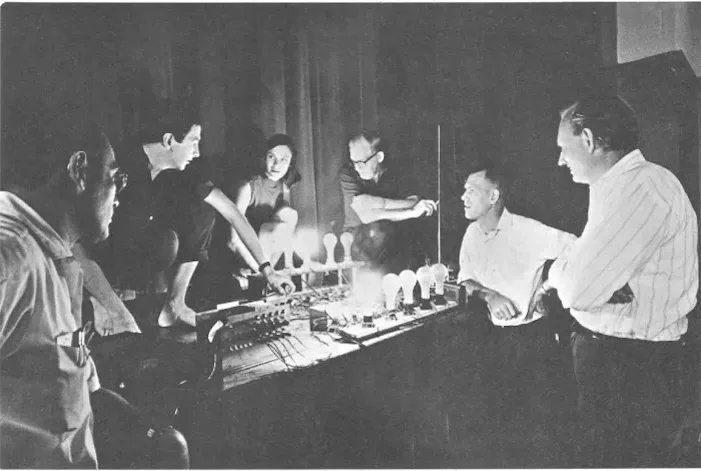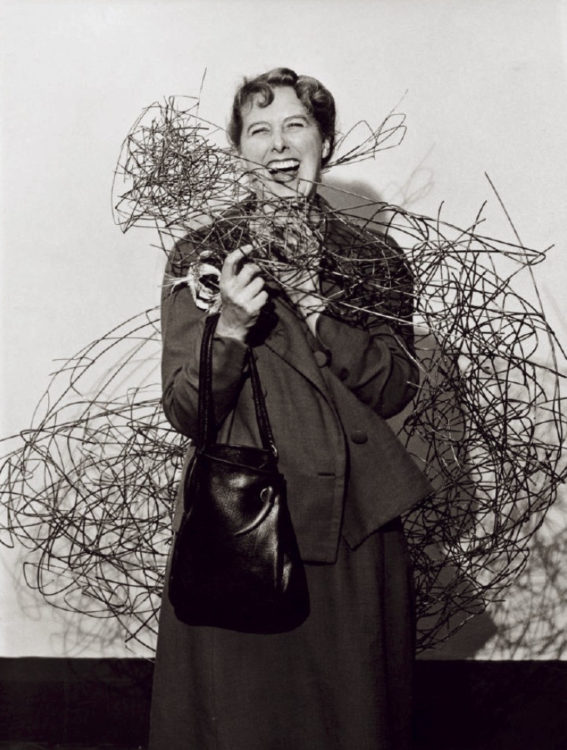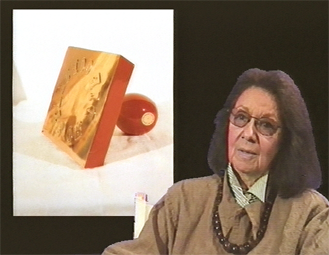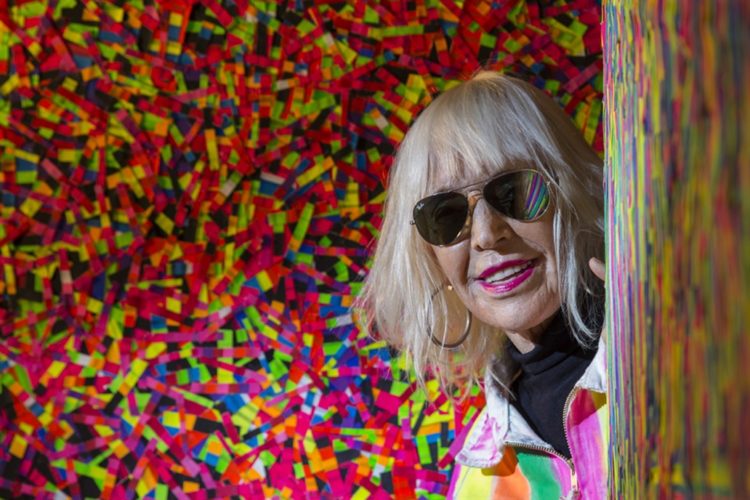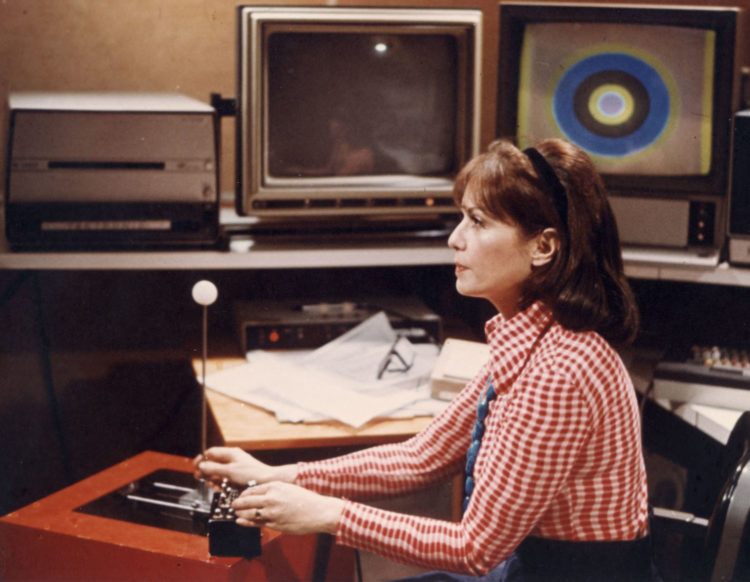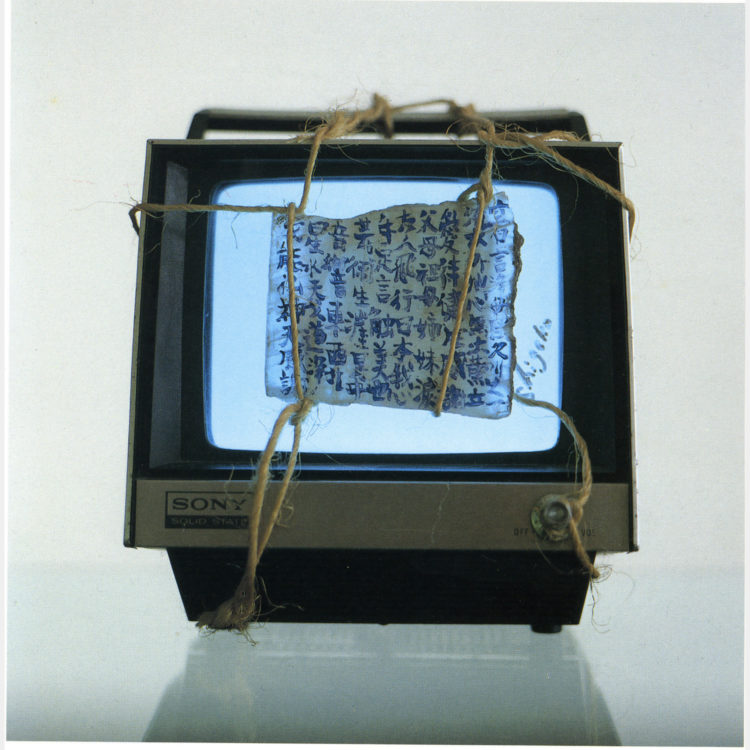Research
Robert Rauschenberg and Lucinda Childs discussing the capabilities of the theatre electronic environmental modulator (TEEM) system with Herb Schneider, L.J. Robinson, Per Biorn, and Billy Klüver at 9 Evenings: Theater and Engineering at the 69th Regiment Armory, New York, October 13–23, 1966. Photograph by Franny Breer. Courtesy of ZKM | Center for Art and Media Karlsruhe, Experiments in Art and Technology (E.A.T.) / ZKM-01-0005-01-0001ks, © ZKM | Karlsruhe, E.A.T.
E.A.T. originated in September 1966 in New York City as a non-profit service organization with the purpose of fostering collaborations between artists, engineers, and scientists. Although its contribution to forming the landscape of technologically based art in the 20th century was quite remarkable, the role of women artists in the collaborations instigated by E.A.T has not been carefully examined. Since it is not possible to answer all of the questions related to the phenomenon here, I will focus on the history of women’s participation in the early years of E.A.T.’s existence.
A mere glance into the archive of E.A.T. reveals active participation by women artists. While certainly very limited compared to male participation, it was much wider in comparison to the mainstream art world, driven by Greenbergian formalism.1 This may surprise, since the organization was governed by men, regarding itself as an engineering society, and members of socially homogenous networks usually provide more help to socially similar network members.2 Moreover, engineering at that time was one of the professional areas with the strongest masculine culture. Technology and science as a means of male domination and the relationship between technologies and gender became the focus of technofeminism starting from the early 1980s.3
Inspired by the technological optimism of the early 1960s, E.A.T. was founded in the general belief that it would greatly benefit society as a whole. Another drive of the organization was its experimental character that valued commitment and collaboration more than a ready product to be sold on the art market. These two claims, undoubtedly nurtured by idealism and utopic universalism, led to its understanding as a service organization for all members of artistic and engineering communities and made its initiatives accessible to more diverse communities in comparison to the conservative mainstream artworld.
Regarding the participation of women artists in particular, it is important to differentiate between various kinds of E.A.T. activities: events upon invitation; ones based on open call; or different programs for which artists could apply. The organization was created during preparations for the performance series, 9 Evenings: Theatre & Engineering, that took place in October 1966. This first event, organized upon invitation, was to become a constitutive and the first large-scale performance of the group. Ten artists took part, three of whom were female: Lucinda Childs (b. 1940), Deborah Hay (b. 1941) et Yvonne Rainer (b. 1934). All of them were members of Judson Dance Theater, as were three male participants, Robert Rauschenberg (1925-2008), Steve Paxton (1939-2024) et Alex Hay (b. 1930). Judson Dance Theater, where postmodern dance took its beginnings and performers of different genders were on equal terms with each other, was remarkable for its spirit of collaboration and experimentation in interdisciplinary performances; this influenced much of E.A.T.’s early philosophy and spirit.
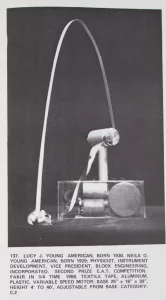
Lucy J. Young, Neils O. Young, Fakir in ¾ Time, 1968, textile tape, aluminum, plastic, variable speed motor. Installation view: Some More Beginnings, Brooklym Museum, New York, November 26, 1968– January 1969. Courtesy ZKM | Center for Art and Media Karlsruhe, Experiments in Art and Technology (E.A.T.) / ZKM-01-0005-01-0002ks, © ZKM | Karlsruhe, E.A.T.
E.A.T. also practiced inclusive formats such as open calls. In 1967, it realized a competition for the best contribution by an engineer to an artwork, providing support to find partners for all of the engineers and artists who wanted to participate. Out of nine projects selected for the final exhibition—a survey The Machine as Seen at the End of the Mechanical Age, curated by Pontus Hultén for MoMA—three were carried out by women artists, almost as many as in the historical part of the show. The jurors were engineers and all of them were male, as were all of the collaborating engineers. Out of the prize-winning projects, there was only one by a female artist: Lucy Jackson Young, for her work Fakir in 3/4 Time.
In parallel to The Machine, E.A.T. decided to organize an exhibition showing almost all of the projects submitted to the competition,4 thus escaping hierarchies and rules established in the art world and questioning the power of the curator as a “gatekeeper.” The exhibition and catalogue, Some More Beginnings: Experiments in Art and Technology, which took place in the Brooklyn Museum, included 27 projects by women artists; some had already been working with different technologies while others were new to the field, whether young or established artists producing their first experiments.
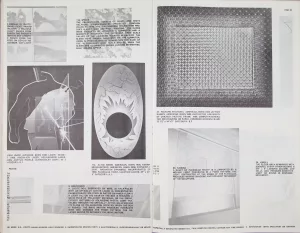
Works by Alyce Simon, Rachel Bas-Cohain, and Aleksandra Kasuba. Installation views: Some More Beginnings, Brooklym Museum, New York, November 26, 1968– January 5, 1969. ZKM | Center for Art and Media Karlsruhe, s in Art and Technology (E.A.T.) / ZKM-01-0005-01-0002ks, © ZKM | Karlsruhe, E.A.T.
Harriet Casdin-Silver (1925–2008) was a pioneer figure in the history of holography, introducing technical innovations in the early history of this medium as well as feminist, provocative subject matter in her works. Claire Falkenstein (1908–1997), most renowned for her abstract and dematerialized wire and glass public sculptures, was inspired by an interest in Einstein’s theories of the universe. Alyce Simon (1925–2011) was equally interested in physics, experimentally creating works using high-voltage particle accelerators. Aleksandra Kasuba (1923-2019), a Lithuanian-born American artist, is best known for her visionary spatial environments made of tensile membranes and works in public spaces. Ruth Francken(1924–2006) was a Czech-American sculptor, painter, and designer, whose output would most often be described as belonging to Pop Art. Ingeborg Richter (1933–2020) experimented with new media and techniques. Jackie Cassen (1935–2010) worked together with Rudi Stern (1936-2006) on Light Shows for Timothy Leary’s Psychedelic Celebrations in the Village Theater in 1965/1966. Lillian Schwartz’s (1927–1924) participation in the show was the beginning of her long-term engagement with computer technology. Rachel Bas-Cohain (1937–1982), a New York–based conceptual artist and founding member of the A.I.R. Gallery, described her work as “air, fluids, light in motion exhibited as sculpture.” Mary Ashley (1931–1996) was an important early video and performance artist, and a member of ONCE Group. Sheila Berkley (1945–2007) created environments such as children’s playgrounds for public spaces. In her wall-reliefs and paintings, Irene Krugman (1925–1982) worked with illusions of space.5
The Technical Services Program, launched in early 1967, was E.A.T.’s main ongoing activity. It was conceived to provide artists with access to new technology and match them with engineers or scientists for one-to-one, project-wise collaborations. No assessment was made of the artistic merit of an artist’s idea or project; all were welcome to use the Technical Services. Due to this openness, the media of such collaborative artworks as well as the quality of their outcome were very diverse.
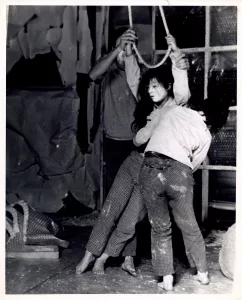
Carolee Schneemann, Snows, 1967, performance, Martinique Theater, New York. Photo: Charlotte Victoria. Shigeko Kubota among the performers. Collaborating engineers: Ralph Flynn, Per Biorn, Robby Robinson
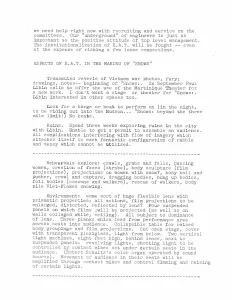
Carolee Schneemann, Aspects of E.A.T. in the Making of “Snows”, in: Compendium of E.A.T. News (Vol.1, No.2, June 1967). ZKM | Center for Art and Media Karlsruhe, Experiments in Art and Technology (E.A.T.) / ZKM-01-0005-01-0013, © ZKM | Karlsruhe, E.A.T.
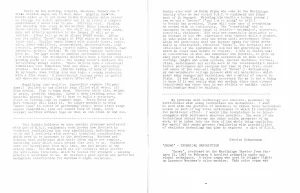
Carolee Schneemann, Aspects of E.A.T. in the Making of “Snows”, in: Compendium of E.A.T. News (Vol.1, No.2, June 1967). ZKM | Center for Art and Media Karlsruhe, Experiments in Art and Technology (E.A.T.) / ZKM-01-0005-01-0013, © ZKM | Karlsruhe, E.A.T.
Carolee Schneemann’s (1939–2019) remarkable kinetic theater piece Snow (1967) was the first single artist’s work to be supported by this program.6 Being a protest work addressing the Vietnam War and its atrocities, it stands out from other collaborations due to its political and activist stance. It expressed a critical attitude towards technology as a means of domination, as practiced by the New Left, but more acutely revealed its potential role in social transformation, as has been shown in research by Christina Filippone.7 The piece combined free-form body movement with film projections and stage props. Several pieces of E.A.T. equipment that had been developed for 9 Evenings were also provided to the artist. Stage elements, humans on the stage, and technology constituted an entangled environment, in which the audience played an active role (its movement activating the cameras, sound, and light machines). C. Schneemann’s aim was to disrupt the understanding of technology as a slick autonomous machine, common in military or industrial use, destabilizing it and breaking its association with perfection—a connection she considered to be dangerous and occurring in both capitalist and fascist societies alike.

Marta Minujín in her work, Minuphone, 1967, phone booth, touch-tone phone, electronic control circuit, built with amplifiers and power sources, dimensions variable. Collaborating engineer: Per Biorn
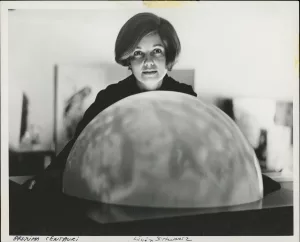
Lillian Schwartz with Proxima Centauri Globe, 1968-1969, gelatin silver print, 20.64 x 25.4 cm. From the Collections of The Henry Ford. Gift of the Lillian F. Schwartz & Laurens R. Schwartz Collection
The installation Minuphone, created in the same year by the Argentinian artist Marta Minujín (b. 1943) in collaboration with Per Biorn of Bell Labs, was one of the artist’s most technically complex pieces. The Minuphone was a multimedia installation in which public participation was key: Visitors were asked to step into an ordinary phone booth and dial a number. Every dialed number triggered a different sequence of auditory, visual, or tactile effects, such as colored water ascending, flashing lights in the ceiling, wind blowing, etc.; at specific moments, the observer would see themselves on a TV screen in the floor. M. Minujín’s criticism of technological consumerism here revealed the individual’s alienation from reality, taking her into a “psychedelic trip,” as well as the dissolution of boundaries between private and public through increasing penetration of technology in everyday life.
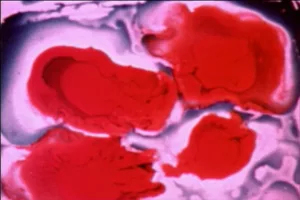
Lillian Schwartz, Still from Pixillation, 1970, film, 3 min 59 sec. Collections of The Henry Ford. ©The Henry Ford
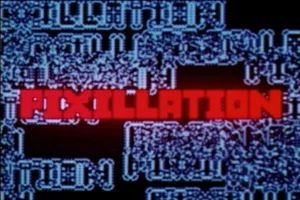
Lillian Schwartz, Still from Pixillation, 1970, film, 3 min 59 sec. Collections of The Henry Ford. ©The Henry Ford
The case of L. Schwartz is an interesting example of a long-term collaboration initiated through E.A.T. During The Machine exhibit at MoMA, where Schwartz showed her kinetic sculpture Proxima Centauri, she met researcher Leon Harmon, who brought her to Bell Labs in 1968. As a resident visitor, she had to work mainly at night when the computers were not in use; Bell Labs later employed her as a computer graphics consultant. Schwartz created ten computer-animated films during her time at the Bell Labs, using technology developed by the engineers of the Lab, including Ken Knowlton. At the beginning (as in Pixillation, 1970) Schwartz processed computer generated images using analog techniques such as painting and collage, as well as photographic material, and combined the images in the film edit.
The outcome of the collaborations between women artists and engineers was as diverse and unpredictable as the idea of experimentation itself. All three of the examples mentioned above were nevertheless groundbreaking for different fields of media art practices. C. Schneemann’s mixed-media performance stands for activist and feminist understanding of technology and its use for societal transformation. M. Minujín created an early example of an interactive installation with a visitor as an active creator. Both artists actively involved the public and its agency while exposing viewers to various technological faults. L. Schwartz’s art stands for early engagement with computing by a whole generation of women artists, whose contributions were unfortunately forgotten or erased.8 No doubt, E.A.T. managed to facilitate the access of these and other women artists to technological and engineering know-how. Unfortunately, it was not able to follow up on projects and, in the long run, the artists involved could not profit from structural support.
E.A.T. Archive at ZKM | Center for Art and Media Karlsruhe. Unfortunately, no gender statistics exist regarding either the membership or participation in E.A.T.’s projects.
2
Cf. Gail M. McGuire, “Gender, Race, and the Shadow Structure: A Study of Informal Networks and Inequality in a Work Organization,” Gender & Society, 16, 3 (2002): 303–322, https://doi.org/10.1177/08912432020160030. The founders of E.A.T. were Billy Klüver and Fred Waldhauer, engineers of the AT&T Bell Laboratories (Bell Labs), and artists Robert Rauschenberg and Robert Whitman. All of them were also represented in different functions in the board of directors; other organizational bodies either consisted only of men or with minimal participation by women (see https://www.experimentsinartandtechnology.org/forming-the-organization (1.10.2024))
3
As of 1980, less than 1 percent of American engineers were women; cf. Christine Filippone, Science, Technology, and Utopias: Women artists and Cold War America. (London & New York: Routlege, 2017): 156. See also a review of historical positions in: Judy Wajcman, Technofeminism (Cambridge: Polity Press, 2004).
4
137 works were shown out of 147 submitted. See the review by Lil Picard, Art by Lil Picard, in Evo, December 13, 1968; E.A.T. Clippings, Vol. 1, No. 1, April 1960–July 1969 (ZKM | Karlsruhe, E.A.T. Archive / 0005 01 0011 KS).
5
Further participants included the painter Martyl (Suzanne Schweig), Kasoundra Kasoundra, Gertrude Barnstone, Kathy Baker, Tracy S. Kinsel, Roberta Phillips, Tania, Amy Hamouda, Merry Bean, Adrienne Bordes, Carol Brown, Charlotte Gilbertson, Muriel Kaplan, Giselle Mauer, Rochon Francine, and Carolyn Walther, about whom very little or no information is available.
6
C. Schneemann believed that E.A.T. supported the piece due to Klüver’s friendship with her partner at that time, James Tenney, a composer of experimental music who also worked at Bell Labs, researching psychoacoustics and creating computer music (see Christine Filippone, Science, Technology, and Utopias, 2, 10).
7
Filippone, Science, Technology, and Utopias, 39–50.
8
Grant David Taylor, “Up for Grabs”: Agency, Praxis, and the Politics of Early Digital Art (https://csalateral.org/original/issue2/theory/taylor/index.html(29.9.2024))
Daria Mille is a curator and research associate at the ZKM | Center for Art and Media Karlsruhe. Her research focuses on the intersection of new media, art, science and technology. D. Mille is also particularly interested in the sphere of experimental practices viewing art institutions as agents of change in their capacity to question canons and to employ more sustainable work and production methods. With extensive experience in curating and managing large-scale exhibition projects both in Germany and internationally, D. Mille has worked across both physical and digital spaces.
Daria Mille, "Experiments in Art and Technology (E.A.T.): Participation of women artists." In Archives of Women Artists, Research and Exhibitions magazine, . URL : https://awarewomenartists.com/en/magazine/experiments-in-art-and-technology-e-a-t-participation-des-artistes-femmes/. Accessed 21 April 2025
